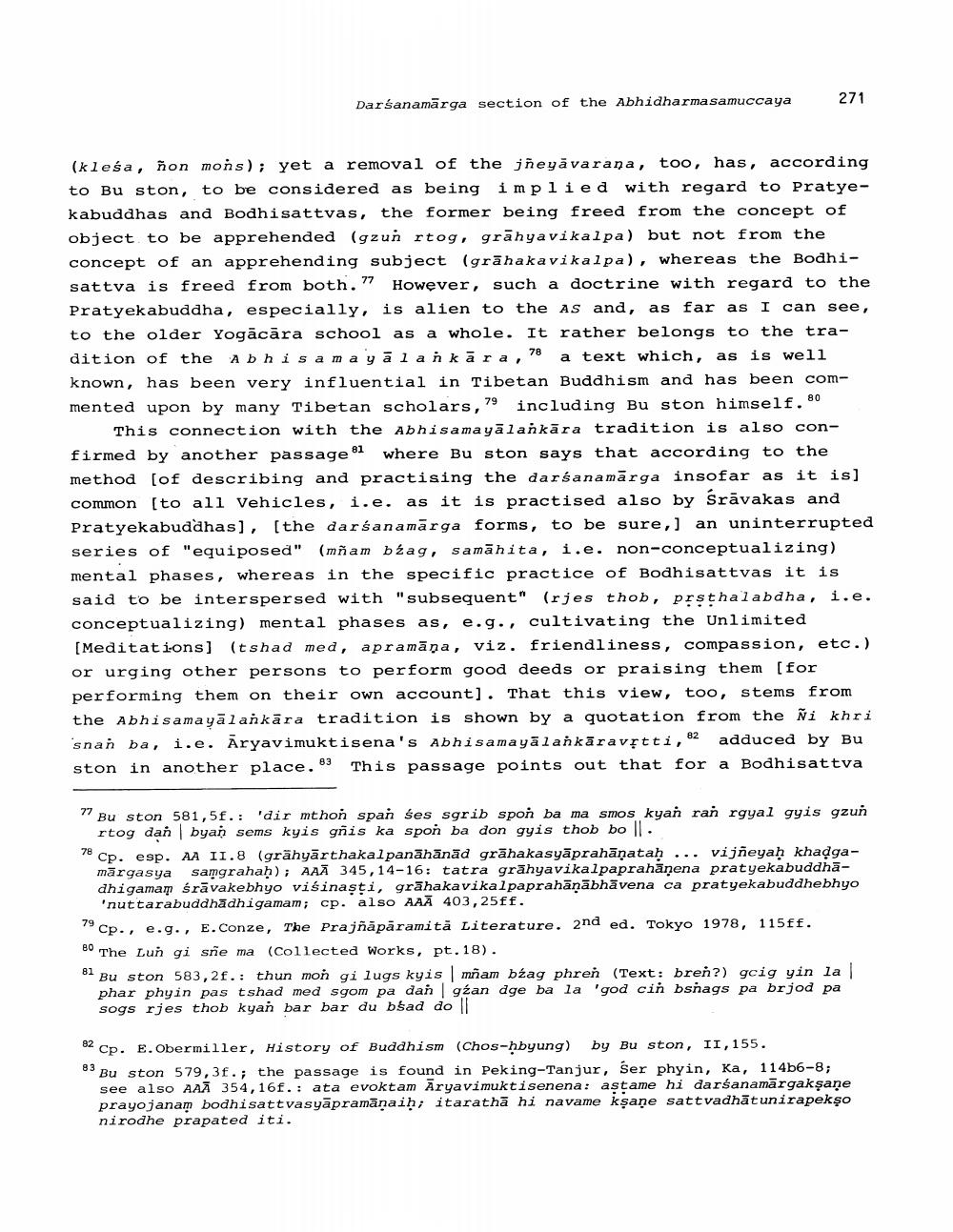________________
(kleśa, non mons); yet a removal of the jñeyavarana, too, has, according to Bu ston, to be considered as being implied with regard to Pratyekabuddhas and Bodhisattvas, the former being freed from the concept of object to be apprehended (gzun rtog, grahya vikalpa) but not from the concept of an apprehending subject (grahakavi kalpa), whereas the Bodhisattva is freed from both. 77 However, such a doctrine with regard to the Pratyekabuddha, especially, is alien to the AS and, as far as I can see, to the older Yogācāra school as a whole. It rather belongs to the tradition of the Abhi samayalan kāra, a text which, as is well known, has been very influential in Tibetan Buddhism and has been commented upon by many Tibetan scholars, including Bu ston himself.80
78
Darśanamarga section of the Abhidharmasamuccaya
81
This connection with the Abhisamayālahkāra tradition is also confirmed by another passage & where Bu ston says that according to the method [of describing and practising the darśanamārga insofar as it is] common [to all Vehicles, i.e. as it is practised also by Śrāvakas and Pratyekabuddhas], [the darśanamarga forms, to be sure,] an uninterrupted series of "equiposed" (mñam bźag, samahita, i.e. non-conceptualizing) mental phases, whereas in the specific practice of Bodhisattvas it is said to be interspersed with "subsequent" (rjes thob, pṛṣṭhalabdha, i.e. conceptualizing) mental phases as, e.g., cultivating the Unlimited [Meditations] (tshad med, apramāņa, viz. friendliness, compassion, etc.) or urging other persons to perform good deeds or praising them [for performing them on their own account]. That this view, too, stems from the Abhisamayālahkāra tradition is shown by a quotation from the Ni khri snah ba, i.e. Aryavimuktisena's Abhisamayalaňkāravṛtti, adduced by Bu ston in another place. This passage points out that for a Bodhisattva
83
78
79
79
271
77 Bu ston 581,5f.: 'dir mthon span ses sgrib spoň ba ma smos kyan ran rgyal gyis gzun rtog daň byan sems kyis gñis ka spoň ba don gyis thob bo ||.
80
82
Cp. esp. AA II.8 (grähyārthakalpanahānād grahakasyāprahāṇataḥ ... vijñeyaḥ khadgamārgasya samgrahaḥ); AAA 345,14-16: tatra grähyavikalpaprahanena pratyekabuddhadhigamam śrāvakebhyo visinaṣṭi, grahakavikalpaprahāṇābhāvena ca pratyekabuddhebhyo 'nuttarabuddhadhigamam; cp. also AAA 403,25ff.
Cp., e.g., E. Conze, The Prajñāpāramitā Literature. 2nd ed. Tokyo 1978, 115ff.
The Lun gi sñe ma (Collected Works, pt.18).
81
Bu ston 583,2f.: thun mon gi lugs kyis | mñam bźag phren (Text: breň?) gcig yin la phar phyin pas tshad med sgom pa dan gźan dge ba la 'god cih bsnags pa brjod pa sogs rjes thob kyan bar bar du bśad do ||
82
Cp. E. Obermiller, History of Buddhism (Chos-hbyung) by Bu ston, II, 155.
83
Bu ston 579,3f.; the passage is found in Peking-Tanjur, Ser phyin, Ka, 114b6-8; see also AAA 354,16f.: ata evoktam Aryavimuktisenena: aṣṭame hi darśanamārgakṣaṇe prayojanam bodhisattvasyāpramānaiḥ; itaratha hi navame kṣane sattvadhātunirapekso nirodhe prapated iti.




